The Apple iPad 2 Review
by Brian Klug, Anand Lal Shimpi & Vivek Gowri on March 19, 2011 8:01 PM ESTThe iPad 2
We've already gone over the iPad 2's design in our preview so I won't spend a ton of time here. The first iPad was a pain to hold in your hand, the iPad 2 largely addresses that problem. The device is similarly sized to its predecessor but Apple removed significant volume by tapering the edges of the iPad 2. The tablet is thus more comfortable to hold, lighter and is significantly thinner than its predecessor. Apple likes to point out that the iPad 2 is now thinner than even the iPhone 4.
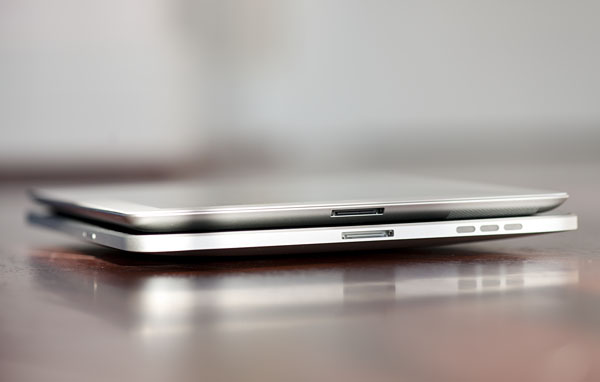
Apple iPad 2 (top), Apple iPad (bottom)
The Xoom to me was more pleasant to hold that the original iPad, however the iPad 2 takes the crown back from Motorola. I believe we'll see second generation Android tablets that rival the iPad 2's thickness but for now you have to keep in mind that we're comparing a second generation iOS tablet to first generation Android tablets. With smartphone internals and virtually nonexistent cooling requirements, building a thin tablet isn't an impossible task.
The front of the iPad 2 is pretty much unchanged from the original, with the exception of the new VGA front facing camera (720p rear camera). As we'll get to shortly, beneath the front of the iPad 2 are a number of magnets for use with Apple's new smart covers. The front bezel of the iPad 2 is available in both white and black. Surprisingly all of the AnandTech editors who contributed to this review opted for the white and all of us seemed to actually be pretty happy with the choice.
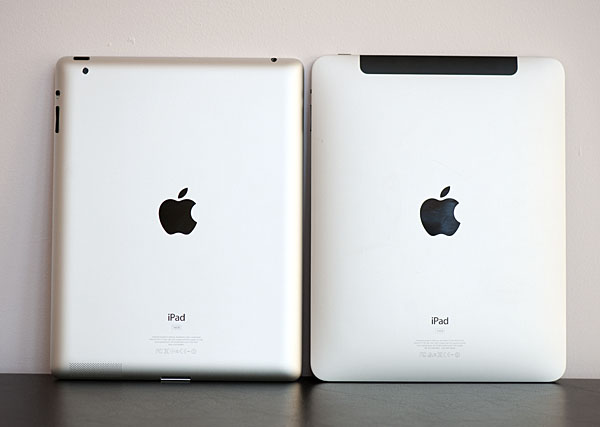
Apple iPad 2 (left), Apple iPad (right)
Flip the iPad 2 around and the back is a very familiar aluminum. Unfortunately with no protection back here you'll often find yourself laying the iPad 2 face down on a smart cover when it's not in use. Even on a clean desk I could hear tons of little particles grinding up against the aluminum. So far the iPad 2 has been pretty resilient, implying that it's made of a harder aluminum than what Apple uses in the MacBook Pro line. That being said, I still worry about scratching the back of the device. Apple makes beautiful products but their beauty isn't always durable.
The button setup hasn't changed since the original iPad. There's the familiar home button on the front (which feels a little softer than the original, but in a good way) and power/lock button up top.
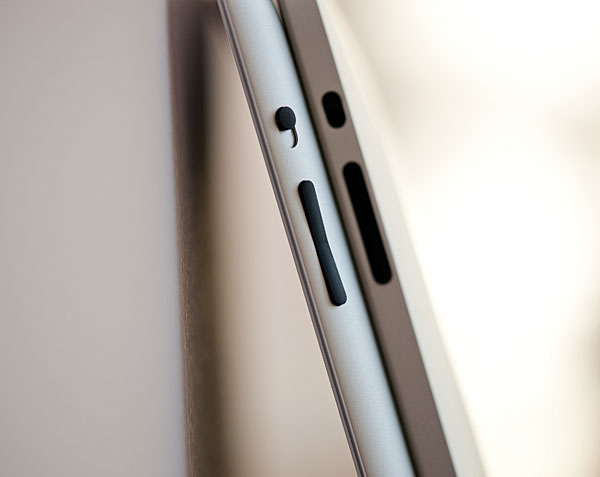
Apple iPad 2 (left), Apple iPad (right)
Along the right side are the mute/rotation switch and the volume rocker. The ends of the volume rocker protrude out further in the iPad 2 than they did with the original - yet another welcome change.
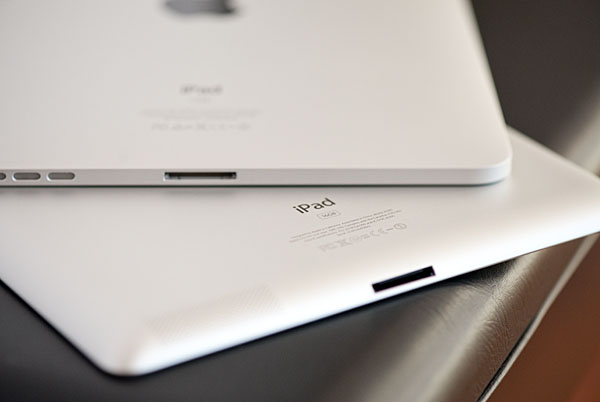
Apple iPad 2 (bottom), Apple iPad (top)
The dock connector is arguably the biggest flaw in the design. Because of the angled edges of the new iPad, the dock connector actually finds itself located in the middle of a slope. As a result inserting a standard dock cable is a bit awkward. On the original iPad you could just line up the cable with the middle of the bottom edge and sneak it in, on the iPad 2 there's more of a guessing game - usually involving me scraping the cable side dock connector against the aluminum back looking for the mate.
Just like last time the iPad 2 is available in both WiFi and 3G versions. The 3G versions add A-GPS support will the WiFi version can only pinpoint your location using WiFi trilateration. Apple offers separate AT&T and Verizon editions of the iPad 2, both of which have the same black antenna bar along the top of the back face of the tablet.
| Apple iPad 2 Pricing Comparison | |||||
| 16GB | 32GB | 64GB | |||
| WiFi | $499 | $599 | $699 | ||
| AT&T 3G | $629 | $729 | $829 | ||
| Verizon 3G | $629 | $729 | $829 | ||
NAND capacities haven't increased, nor have prices. We likely won't see an increase in storage capacity until 25nm NAND ships in greater volume. The iPad 3 will probably start at 32GB and go all the way up to 128GB as a result.
Regardless of carrier, the 3G models require a $130 premium over the WiFi only models. Personally I'd say that some sort of cellular data connectivity is really necessary to make the iPad 2 as useful as possible. Whether that comes from a 3G model or through a MiFi/smartphone hotspot doesn't really matter.
The pricing as a whole is still absurd. Even if you opt for the $499 WiFi version you'll be out another $39 for a case, plus another $39 if you want the HDMI adapter and then there are all of the apps you will likely start buying. This is an expensive platform to buy into and rest assured that there will be an even faster version out next year. Apple hasn't had much pricing pressure from the competition, however as we mentioned in our CES 2011 coverage - ASUS will be shipping a $399 Honeycomb tablet this year that should start to change that.


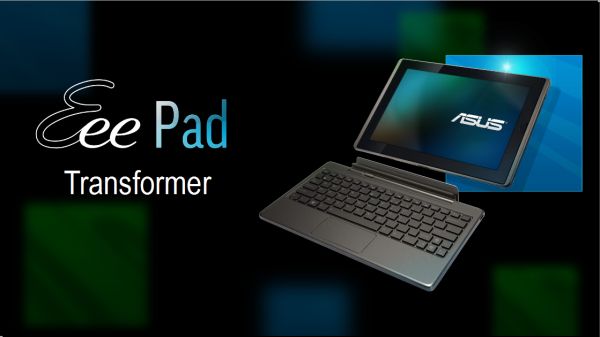








189 Comments
View All Comments
george1924 - Saturday, March 19, 2011 - link
Seems to be fixed nowAnand Lal Shimpi - Saturday, March 19, 2011 - link
Thanks for the correction :)Take care,
Anand
drugos - Saturday, March 19, 2011 - link
As usual, one of the most comprehensive reviews on the net. Thanks guys!Bosh - Sunday, March 20, 2011 - link
Yes, as usual !PrinceGaz - Saturday, March 19, 2011 - link
Who buys worthless over-priced rubbish like the iPad, apart from hipsters/dickheads? I can understand the appeal of it to them, and I've nothing against dickheads who love them, but what purpose do they serve to the rest of us?!?It's incapable of being used for real work so basically useless except as a toy when out and about, but too large to be carried around in anything smaller than what a small laptop could be carried in, so what it can do when on the move may as well be done on a smartphone.
B3an - Saturday, March 19, 2011 - link
Cant beleive i'm saying this about an Apple product... but the iPad 2 isn't expensive for the hardware. Look at the Motorola Xoom which is lot more expensive for marginally better hardware, although the iPad 2 has better hardware in some areas. The thing is though Apple can sell the iPad 2 at little profit because they just make the money from app sales. So it's hard for other tablet makers to compete on price.I agree with everything else though.
shabby - Saturday, March 19, 2011 - link
The ipad2 is expensive, imagine if asus took their $250 10" netbook and removed the keyboard, replaced the hard drive with a sd card for memory, and ditched the intel mobo/cpu for a slower soc this thing would cost maybe $150.The only reason these devices have these prices is because that's how much people are willing to pay for them.
As for the xoom, motorola for some reason thinks they can charge a premium for it, they certainly are smoking some good shit. These phone manufacturers will fail with their expensive tablets.
Once asus and other netbook manufacturers start saturating the market with android tablets you'll start seeing cheaper solutions.
jalexoid - Saturday, March 19, 2011 - link
That is not true. FOB price for the 16GB XOOM clone(proper quality clone, not a knockoff) is about $330. Smaller components cost more.WaltFrench - Sunday, March 20, 2011 - link
“The only reason these devices have these prices is because that's how much people are willing to pay for them.”Showing off the fact that we've had Econ 101, are we?
Perhaps there's some object/service that operates differently that you'd care to mention.
kukabuka - Saturday, March 19, 2011 - link
Well, I for one think tablets are really great when you don't need a keyboard or a fast processor or a lot of storage. Which would be never. If the iPad sells way better than the Xoom, I'd say your theory about hipsters/dickheads being the only market group for tablets is confirmed.